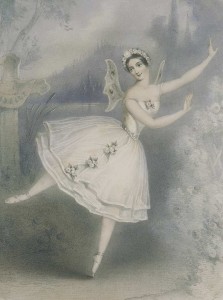By Bob Hicks
The world of ballet has its share of exotic creatures, from lovelorn swan-women to a magical firebird to a princess who takes a hundred-year nap.
 But no one seems quite as oddball, or as eerily sympathetic and nasty at the same time, as the Wilis, those sad young spectres of girls who were jilted by their lovers before their wedding day and now spend their nights madly dancing young men to death before fading off into the sunrise.
But no one seems quite as oddball, or as eerily sympathetic and nasty at the same time, as the Wilis, those sad young spectres of girls who were jilted by their lovers before their wedding day and now spend their nights madly dancing young men to death before fading off into the sunrise.
Tuesday night, Oregon Ballet Theatre threw a little party in its studios to announce its 2011-12 season, and one of the highlights of the lineup is Giselle, the venerable story ballet in which the Wilis rose to fame.
Here’s the new season lineup:
To begin, Petrouchka and Carmen. A two-fer, not unlike Portland Opera’s popular pairing of Pagliacci and Carmina Burana, that will use the same sets and designs in an attempt to create a unified evening. Petrouchka, the story of the sad puppet who comes alive, should be a good followup to this season’s Stravinsky Project, which plays Feb. 26-March 5 and will include Firebird, The Rite of Spring, and a new, contemporary collaborative piece to Stravinsky’s music with choreography by Anne Mueller, Jamey Hampton, Ashley Roland and Rachel Tess. Petrouchka made its debut in 1911, and Stravinsky revised its instrumentation in 1947. This one will be a premiere with choreography by Nicolo Fonte (OBT’s Bolero and Left Unsaid). Carmen, using Bizet’s opera score, will also be a premiere, this one by OBT artistic director Christopher Stowell. Oct. 8-15.
A Holiday Revue and George Balanchine’s The Nutcracker. Sugar Plum Fairy and friends Dec. 11-24. And Stowell will do another version of the seasonal revue that debuted to audience applause in December, once again with singer Susannah Mars and pianist Richard Bower joining the dancers for a cabaret-style show. Dec. 10-22.
Giselle. Giselle made its premiere in 1841, which puts it in an entirely different category from the later classical story ballets that have entered the canon. Unlike most modern versions, which fashion themselves after Marius Petipa’s revivals from the 1880s and later, OBT’s — with choreography by Romantic ballet specialist Lola de Avila, who was at San Francisco Ballet when Stowell danced there — will take its cues from the original choreography by Jean Coralli and Jules Perrot. The music, of course, will be Adolphe Adam’s 1841 score. As Stowell pointed out Tuesday night, the dancing style of the time was less sweeping than during the great Tchaikovsky years a few decades later, but was technically demanding. The challenge — and it’s a fascinating one — will be to convey a sense of historical accuracy and also keep the dance fresh. Feb. 25-March 3, 2012.
Chromatic Quartet. An evening of four dances in the more intimate Newmark Theatre (other productions are in the 3,000-seat Keller Auditorium) that will test the steel, skill and versatility of the company dancers. The program will include Balanchine’s gorgeous and difficult Stravinsky Violin Concerto; Val Caniparoli’s Lambarena, which blends traditional African music with Bach; and the company premiere of Christopher Wheeldon‘s Liturgy, to a score by Arvo Part. The fourth piece hasn’t been determined, but it will be a premiere: Stowell says he’s talking with several leading choreographers. April 19-28, 2012.
*
Lithograph by unknown artist of the ballerina Carlotta Grisi in “Giselle.” Paris, 1841. Image was scanned from the book “The Romantic Ballet in Paris” by Ivor Guest. Wikimedia Commons.